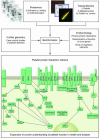Platelet genomics and proteomics in human health and disease
- PMID: 16322782
- PMCID: PMC1297260
- DOI: 10.1172/JCI26885
Platelet genomics and proteomics in human health and disease
Abstract
Proteomic and genomic technologies provide powerful tools for characterizing the multitude of events that occur in the anucleate platelet. These technologies are beginning to define the complete platelet transcriptome and proteome as well as the protein-protein interactions critical for platelet function. The integration of these results provides the opportunity to identify those proteins involved in discrete facets of platelet function. Here we summarize the findings of platelet proteome and transcriptome studies and their application to diseases of platelet function.
Figures



References
-
- Weyrich AS, Zimmerman GA. Platelets: signaling cells in the immune continuum. Trends Immunol. 2004;25:489–495. - PubMed
-
- Nurden, A.T., and Nurden, P., editors. 2002. Inherited disorders of platelet function. Academic Press. London, United Kingdom. 681–700.
-
- Shields DC, et al. The contribution of genetic factors to thrombotic and bleeding outcomes in coronary patients randomised to IIb/IIIa antagonists. Pharmacogenomics J. 2002;2:182–190. - PubMed
-
- Hetherington SL, et al. Dimorphism in the P2Y1 ADP receptor gene is associated with increased platelet activation response to ADP. Arterioscler. Thromb. Vasc. Biol. 2005;25:252–257. - PubMed
-
- Joutsi-Korhonen L, et al. The low-frequency allele of the platelet collagen signalling receptor glycoprotein VI is associated with reduced functional responses and expression. Blood. 2003;101:4372–4379. - PubMed
Publication types
MeSH terms
Substances
LinkOut - more resources
Full Text Sources
Other Literature Sources

